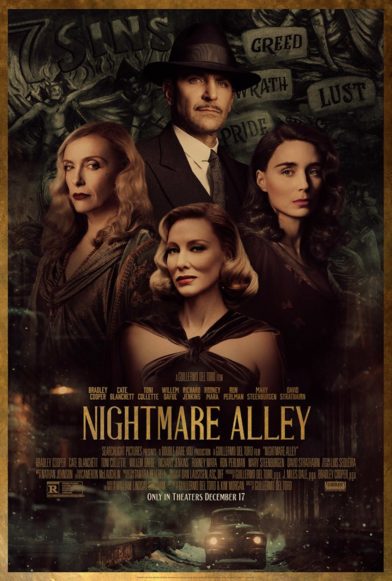
The second film to be adapted from William Lindsay Gresham’s classic 1946 novel—with the first being a 1947 film noir, followed by a stage musical and a graphic novel—was this ambitious 2021 production by the inimitable Guillermo Del Toro. Given such a myriad of NIGHTMARE ALLEY adaptations, the question of whether another was necessary is a fair one, and one I’ll have to answer in the negative.
That Del Toro was coming off the multi-Oscar winning THE SHAPE OF WATER (2017) explains how he was able to make a generously budgeted film from one of the absolute bleakest and most unforgiving novels ever written. The production, like countless others, was affected by the 2020 covid-19 shut-down (note all the “COVID coordinators” listed in the end credits), and also the fact that its proposed star Leonardo DiCaprio, who reportedly turned down several high-profile projects in order to appear in it, ended up pulling out. His replacement was Bradley Cooper, who was also given a producer credit, and who, with his old school Hollywood air, makes for an excellent fit with the material.
That Del Toro was coming off the multi-Oscar winning THE SHAPE OF WATER (2017) explains how he was able to make a generously budgeted film from one of the absolute bleakest and most unforgiving novels ever written.
Yet the film is driven primarily by the power of Gresham’s novel, which for the most part was faithfully transposed by Del Toro. Related is the late 1930s-early 40s set story of Stanton Carlisle (Cooper), a good-looking drifter who after killing his hated father in a house fire becomes embroiled in the doings of a sleazy carnival. Upon witnessing a geek going about his nasty doings Stan is repulsed but also intrigued. He discovers a real talent for grifting, which he proves by convincing an overzealous sheriff looking to shut down the carnival that Stan is in touch with the man’s deceased wife.
Ignoring some rather blatant foreshadowing of his eventual fate—in a prescient tarot card reading and an accidental murder precipitated by Stan—and a stern warning against taking his act too seriously, Stan runs off with Molly, the sexy girlfriend of the circus’ jealous strong man. Molly becomes Stan’s accomplice in a nightclub act in which he pretends to be psychic (in place of the privately held seances of the novel). The act brings him enormous fame, but also arouses the suspicions of Lilith, a corrupt psychiatrist. She becomes his unlikely partner in crime, and also the primary catalyst in his inevitable downfall (her name really should have tipped him off).
That downfall involves a grift brought about by a wealthy client named Ezra Grindle. He’s grief-stricken over the death of a lover from an induced miscarriage, and Stan, utilizing information gleaned by infiltrating Lilith’s files, claims to be in touch with the dead woman’s spirit. He proposes to materialize that spirit in the form of Molly, who’s been having second thoughts about her relationship with Stan. The gambit, needless to say, goes spectacularly wrong, with grave consequences for everyone, Stan in particular.
Del Toro has a taste for the extravagant that tends to work against his efforts, as proven by MIMIC and HELLBOY 2: THE GOLDEN ARMY. His best work, like PAN’S LABYRINTH and THE SHAPE OF WATER, tends to be more grounded and contained, but NIGHTMARE ALLEY, unfortunately, is more akin to the former films in its approach.
Del Toro has a taste for the extravagant that tends to work against his efforts…
The film is over-stylized and inauthentic. That’s in direct opposition to THE SHAPE OF WATER, whose portrayal of 1950s-era America felt extremely on-target, and also the Gresham novel, which was above all else gritty and naturalistic. The fake Southern accents by a variety of familiar faces—Rooney Mara, Toni Collette, Cate Blanchett, Willem Dafoe, Mary Steenburgen and Del Toro regular Ron Perlman—are, despite generally solid acting (and some shameless overacting by Blanchett as Lilith), a constant annoyance, as are cinematographer Dan Lausten’s self-consciously noirish visuals. The film looks good, certainly, but the pictorial splendor works against the material.
Far more appropriate is Del Toro’s unerring eye for the freakish and, in the latter scenes (which grow extremely bloody), grotesque.
Far more appropriate is Del Toro’s unerring eye for the freakish and, in the latter scenes (which grow extremely bloody), grotesque. That, together with Del Toro’s undoubted reverence for the source material—whose famously bleak ending (unlike in the 1947 NIGHTMARE ALLEY) is transferred to the screen virtually intact—makes for a film that qualifies as a conditional success.
(See also On NIGHTMARE ALLEY)
Vital Statistics
NIGHTMARE ALLEY
20th Century Studios/TSG Entertainment Inc.
Director: Guillermo Del Toro
Producers: Guillermo Del Toro, J. Miles Dale, Bradley Cooper
Screenplay: Guillermo Del Toro, Kim Morgan
(Based on a novel by William Lindsay Gresham)
Cinematography: Dan Lausten
Editing: Cameron McLaughlin
Cast: Bradley Cooper, Rooney Mara, Cate Blanchett, Toni Collette, Willem Dafoe, Richard Jenkins, Ron Perlman, David Strathairn, Mary Steenburgen, Mark Povinelli, Peter MacNeill, Holt McCallany, Paul Anderson, Lara Jean Chorostecki, Jim Beaver, Clifton Collins Jr., Tim Blake Nelson, David Hewlett
